Topological Transitions in Collective Housing Units of South Korea
Abstract
:1. Introduction
2. Premises of Phylogenetic Trees in Architectural Planning and Design Studies
3. Overview
3.1. Graph-Based Spatial Structure Similarity Analysis
3.2. Time-Based Joining Method for Generating Phylogenetic Trees
- (a)
- There are eight cases (a to h plans) as analysis targets.
- (b)
- A set of plans that have identical spatial structures is defined as a plan type, and these are collected as a group. The generation time for each plan type is determined based on the earliest completion date.
- (c)
- The similarities of each plan type with the plan types that are chronologically earlier are calculated, and the plans with the highest similarity are paired. In this pair, the plan type that is chronologically earlier becomes the precedent, while the plan type that is chronologically later becomes the descendent.
- (d)
- The above procedure is iterated to derive the precedent–descendent relationships, which are then represented as a single connected relationship to create a phylogenetic tree. In the present study, the similarity between spatial structures was calculated using the bipartite methodology proposed by Heymans and Singh [20].
3.3. Characteristics of Dwellings in South Korea
3.4. Introduction and Changes in Apartment Structures
4. Generation of the Phylogenetic Tree
4.1. Generation of a Phylogenetic Tree for Spatial Structures
- (1)
- A family in which the entrance and hall are connected (2A-1, plan type 12, 1988).
- (2)
- A family in which the entrance, hall, and living room are interconnected (2A-2, plan type 10, 1987).
4.1.1. Family 2A
4.1.2. Family 2B
4.2. Differentiation Analyses by Combinations of Rooms
4.2.1. An Area of Hall, Living Room, and Entrance
4.2.2. An Area of Kitchen/Dining Room
4.2.3. An Area of Main Room
5. Conclusions
Author Contributions
Conflicts of Interest
Appendix A
| Year | Kitchen/Dining Room and Other Rooms | Hall, Living Room, and Kitchen/Dining Room | Entrance, Hall, and Living Room | Main Room, Bath Room, and Dressing Room | ||||||||||
|---|---|---|---|---|---|---|---|---|---|---|---|---|---|---|
| A | B | C | D | E | A | B | A | B | C | A | B | C | D | |
| 1979 | 0 | 1 | 0 | 0 | 0 | 1 | 0 | 1 | 0 | 0 | 1 | 0 | 0 | 0 |
| 1980 | 1 | 0 | 0 | 0 | 0 | 1 | 0 | 1 | 0 | 0 | 1 | 0 | 0 | 0 |
| 1981 | 0 | 0 | 0 | 0 | 0 | 0 | 0 | 0 | 0 | 0 | 0 | 0 | 0 | 0 |
| 1982 | 2 | 1 | 0 | 0 | 0 | 3 | 0 | 3 | 0 | 0 | 3 | 0 | 0 | 0 |
| 1983 | 10 | 0 | 0 | 0 | 0 | 10 | 0 | 10 | 0 | 0 | 10 | 0 | 0 | 0 |
| 1984 | 5 | 1 | 0 | 0 | 0 | 6 | 0 | 6 | 0 | 0 | 6 | 0 | 0 | 0 |
| 1985 | 5 | 0 | 0 | 0 | 0 | 5 | 0 | 5 | 0 | 0 | 5 | 0 | 0 | 0 |
| 1986 | 7 | 1 | 0 | 1 | 0 | 9 | 0 | 8 | 1 | 0 | 8 | 1 | 0 | 0 |
| 1987 | 4 | 1 | 0 | 1 | 0 | 6 | 0 | 4 | 2 | 0 | 5 | 1 | 0 | 0 |
| 1988 | 10 | 10 | 1 | 0 | 0 | 21 | 0 | 19 | 2 | 0 | 12 | 9 | 0 | 0 |
| 1989 | 1 | 11 | 4 | 0 | 0 | 16 | 0 | 14 | 2 | 0 | 2 | 14 | 0 | 0 |
| 1990 | 2 | 10 | 4 | 1 | 0 | 17 | 0 | 9 | 8 | 0 | 2 | 15 | 0 | 0 |
| 1991 | 2 | 23 | 4 | 0 | 0 | 29 | 0 | 14 | 15 | 0 | 3 | 26 | 0 | 0 |
| 1992 | 6 | 35 | 11 | 0 | 0 | 51 | 1 | 25 | 25 | 2 | 2 | 50 | 0 | 0 |
| 1993 | 3 | 28 | 9 | 2 | 1 | 42 | 1 | 20 | 23 | 0 | 3 | 40 | 0 | 0 |
| 1994 | 2 | 31 | 16 | 4 | 0 | 52 | 1 | 15 | 37 | 1 | 2 | 51 | 0 | 0 |
| 1995 | 0 | 33 | 11 | 1 | 0 | 45 | 0 | 26 | 18 | 1 | 0 | 45 | 0 | 0 |
| 1996 | 2 | 30 | 7 | 1 | 0 | 38 | 2 | 16 | 24 | 0 | 1 | 39 | 0 | 0 |
| 1997 | 0 | 42 | 12 | 2 | 0 | 56 | 0 | 7 | 49 | 0 | 0 | 56 | 0 | 0 |
| 1998 | 4 | 58 | 14 | 2 | 0 | 77 | 1 | 9 | 69 | 0 | 2 | 76 | 0 | 0 |
| 1999 | 3 | 81 | 13 | 1 | 0 | 97 | 1 | 16 | 82 | 0 | 1 | 97 | 0 | 0 |
| 2000 | 1 | 55 | 17 | 2 | 0 | 75 | 0 | 11 | 64 | 0 | 0 | 75 | 0 | 0 |
| 2001 | 1 | 37 | 10 | 3 | 0 | 51 | 0 | 12 | 39 | 0 | 1 | 48 | 1 | 1 |
| 2002 | 1 | 33 | 8 | 1 | 0 | 43 | 0 | 9 | 34 | 0 | 0 | 38 | 4 | 1 |
| 2003 | 0 | 30 | 12 | 3 | 2 | 46 | 1 | 3 | 44 | 0 | 0 | 38 | 5 | 4 |
| 2004 | 6 | 23 | 9 | 0 | 0 | 37 | 1 | 8 | 30 | 0 | 2 | 25 | 9 | 2 |
| 2005 | 3 | 13 | 7 | 0 | 0 | 22 | 1 | 8 | 15 | 0 | 1 | 17 | 4 | 1 |
| 2006 | 2 | 11 | 2 | 1 | 0 | 16 | 0 | 5 | 11 | 0 | 1 | 9 | 3 | 3 |
| 2007 | 2 | 6 | 0 | 0 | 0 | 8 | 0 | 2 | 6 | 0 | 1 | 6 | 1 | 0 |
| 2008 | 0 | 0 | 1 | 0 | 0 | 1 | 0 | 1 | 0 | 0 | 0 | 1 | 0 | 0 |
| 2009 | 0 | 1 | 0 | 0 | 0 | 1 | 0 | 1 | 0 | 0 | 0 | 1 | 0 | 0 |
| 2010 | 0 | 1 | 0 | 0 | 0 | 1 | 0 | 1 | 0 | 0 | 0 | 1 | 0 | 0 |
| 2011 | 0 | 0 | 0 | 1 | 0 | 1 | 0 | 0 | 1 | 0 | 0 | 0 | 1 | 0 |
| 2012 | 0 | 0 | 0 | 0 | 0 | 0 | 0 | 0 | 0 | 0 | 0 | 0 | 0 | 0 |
| 2013 | 0 | 1 | 0 | 0 | 0 | 1 | 0 | 1 | 0 | 0 | 0 | 1 | 0 | 0 |
| 2014 | 0 | 1 | 0 | 0 | 0 | 1 | 0 | 0 | 1 | 0 | 0 | 1 | 0 | 0 |
| 2015 | 0 | 1 | 0 | 0 | 0 | 1 | 0 | 0 | 1 | 0 | 0 | 1 | 0 | 0 |
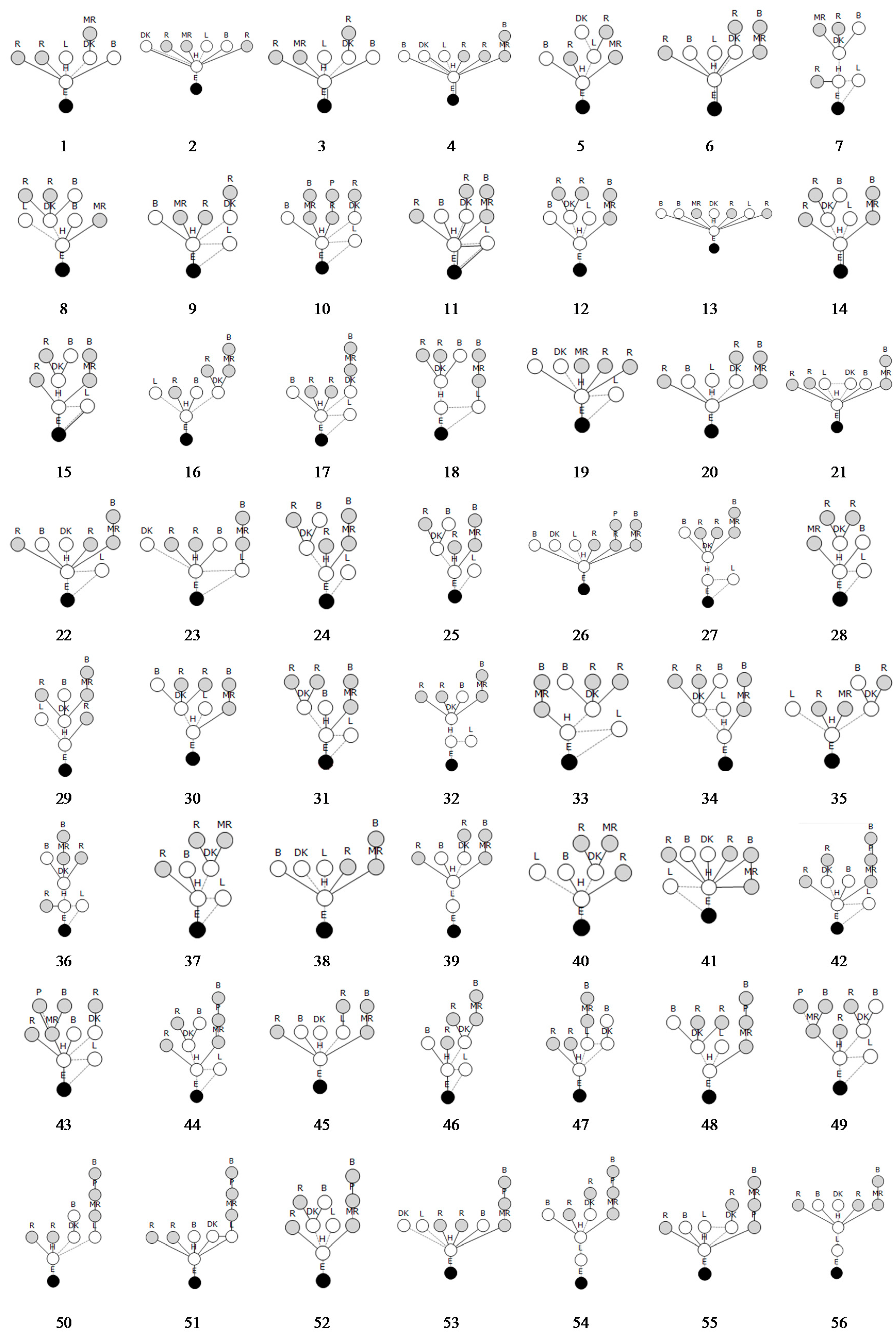
References
- Statics Korea Population and Housing Census. Available online: http://kosis.kr/statHtml/statHtml.do?orgId=101&tblId=DT_1JU0001&conn_path=I2 (accessed on 30 July 2016).
- Lee, D. Spatial Configuration Characteristics of Apartment Units by Plan Size Using Genotype Analysis Method. Ph.D. Thesis, Yonsei University, Seoul, Korea, 2004. [Google Scholar]
- Seo, K.W. Spatial Interpretation of Housing: The Role of Topological Intuition in the Evolution of the Houses in Seoul. Ph.D. Thesis, University College London, London, UK, 2005. [Google Scholar]
- Bustard, W. Space, evolution, and function in the houses of Chaco Canyon. Environ. Plan. B Plan. Des. 1999, 26, 219–240. [Google Scholar] [CrossRef]
- Bandyopadhyay, A.; Merchant, A.N. Space syntax analysis of colonial houses in India. Environ. Plan. B Plan. Des. 2006, 33, 923–942. [Google Scholar] [CrossRef]
- Guney, Y.I.; Wineman, J. The evolving design of 20th-century apartments in Ankara. Environ. Plan. B Plan. Des. 2008, 35, 627–646. [Google Scholar] [CrossRef]
- Hillier, B.; Hanson, J. The Social Logic of Space; Cambridge University Press: Cambridge, UK, 1984. [Google Scholar]
- Ham, S.; Lee, G. Time-Based Joining Method for Generating Phylogenetic Trees of Architectural Plans. J. Comput. Civ. Eng. 2016. [Google Scholar] [CrossRef]
- Ham, S. A Study on the Generation Method of a Phylogenetic Tree by the Similarity of Architectural Space. Ph.D. Thesis, Yonsei University, Seoul, Korea, 2011. [Google Scholar]
- Ham, S. Analysis on the Change of Apartment House Spatial Structure Using Time Based-Joining Method—Focusing on Two-Unit-Staircase and 3-Bay Type Apartment House with an Area of Usable Space of 85 m2 Located in Seoul. J. Archit. Inst. Korea Plan. Des. 2016, 32, 3–10. [Google Scholar] [CrossRef]
- Bafna, S. Geometrical intuitions of genotypes. In The 3rd Space Syntax, Symposium; College of Architecture, Georgia Institute of Technology: Atlanta, GA, USA, 2001; Available online: http://www.ucl.ac.uk/bartlett/3sss/papers_pdf/20_bafna.pdf (accessed on 27 December 2016).
- Bafna, S. A Morphology of Intentions: An Interpretation of Mies Van Der Rohe’s Residentia; College of Architecture, Georgia Institute of Technology: Atlanta, GA, USA, 2001. [Google Scholar]
- Conroy Dalton, R.; Kirsan, C. Small-graph matching and building genotypes. Environ. Plan. B Plan. Des. 2008, 35, 810–830. [Google Scholar] [CrossRef]
- Simpson, M.G. Plant Systematics; Elsevier Science: Burlington, MA, USA, 2010. [Google Scholar]
- Sanfeliu, A.; Fu, K.-S. A distance measure between attributed relational graphs for pattern recognition. IEEE Trans. Syst. Man Cybern. 1983, 3, 353–362. [Google Scholar] [CrossRef]
- Bunke, H. On a relation between graph edit distance and maximum common subgraph. Pattern Recogn. Lett. 1997, 18, 689–694. [Google Scholar] [CrossRef]
- Kleinberg, J.M. Authoritative sources in a hyperlinked environment. J. ACM 1999, 46, 604–632. [Google Scholar] [CrossRef]
- Melnik, S.; Garcia-Molina, H.; Rahm, E. Similarity flooding: A versatile graph matching algorithm and its application to schema matching. In Proceedings of the 18th International Conference on Data Engineering (ICDE), San Jose, CA, USA, 26 February–1 March 2002; pp. 117–128.
- Jeh, G.; Widom, J. SimRank: A Measure of Structural-Context Similarity; Stanford InfoLab: Stanford, CA, USA, 2001. [Google Scholar]
- Heymans, M.; Singh, A.K. Deriving phylogenetic trees from the similarity analysis of metabolic pathways. Bioinformatics 2003, 19 (Suppl. S1), i138–i146. [Google Scholar] [CrossRef] [PubMed]
- Leicht, E.A.; Holme, P.; Newman, M.E.J. Vertex similarity in networks. Phys. Rev. E 2006, 73, 026120. [Google Scholar] [CrossRef] [PubMed]
- Jeon, N.; Son, S.; Yang, S.; Hyeonguk, H. Social History of the Korea Housing/History of the Modern and Contemporary Korea Housing; Dolbege: Seoul, Korea, 2008; pp. 192–195. [Google Scholar]
- Kang, B.; Kaing, I.; Park, G.; Park, I.; Park, C.; Baek, H.; Lee, G. History of the Korea Apartment Plan; Sejin: Seoul, Korea, 1999. [Google Scholar]
- Kwon, H.-S.; Chun, W.-H.; Park, J.-Y. A study on the efficient utilization plan of balcony space in apartment. In the 2006 Fall Conference of the Architectural Institute of Korea; The Architectural Institute of Korea: Daegu, Korea, 2006; Volume 26, pp. 81–84. Available online: https://m.riss.kr/search/detail/DetailView.do?p_mat_type=1a0202e37d52c72d&control_no=3639e7b58250d24cffe0bdc3ef48d419 (accessed on 27 December 2016). (In Korean)
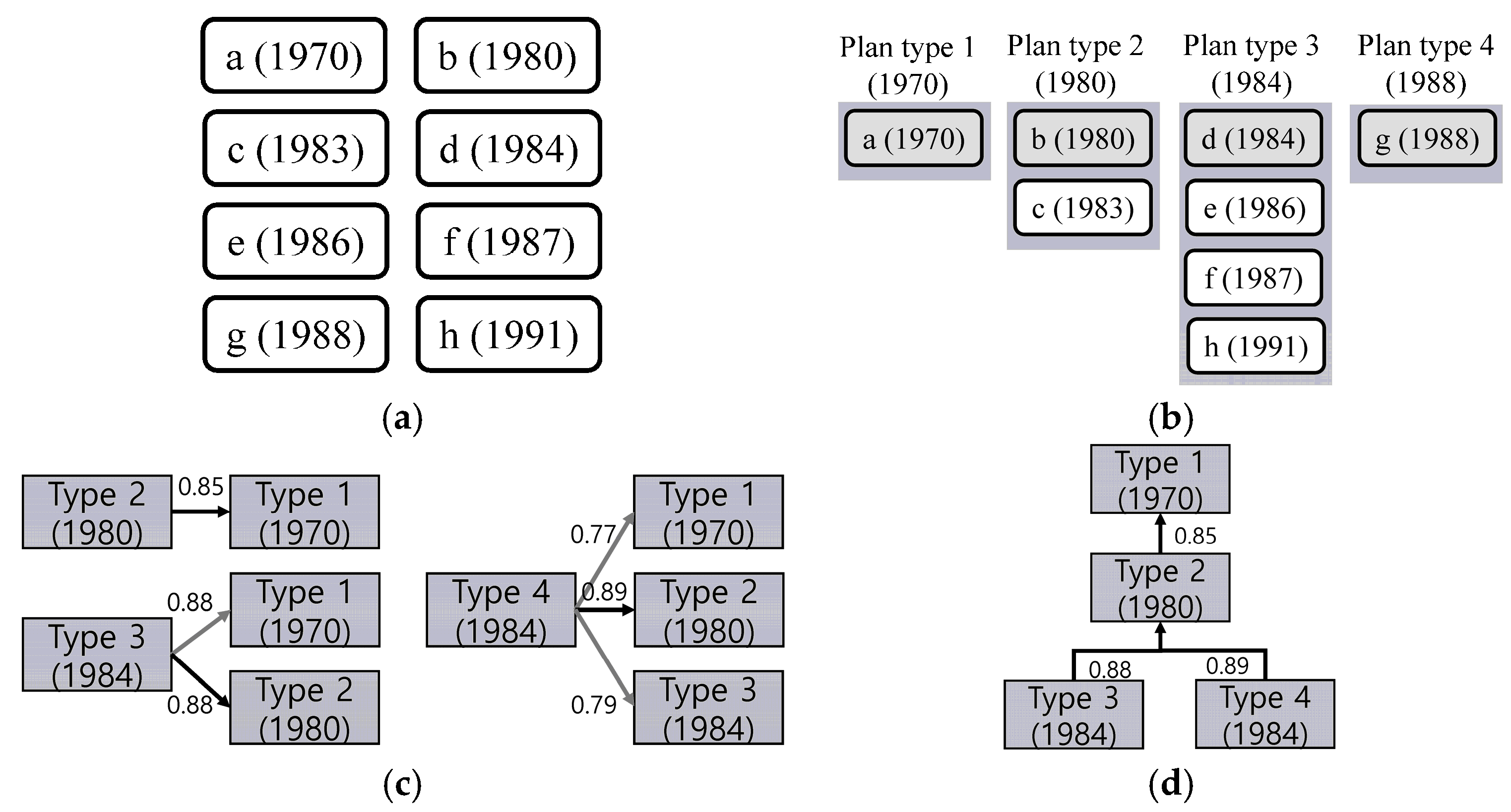
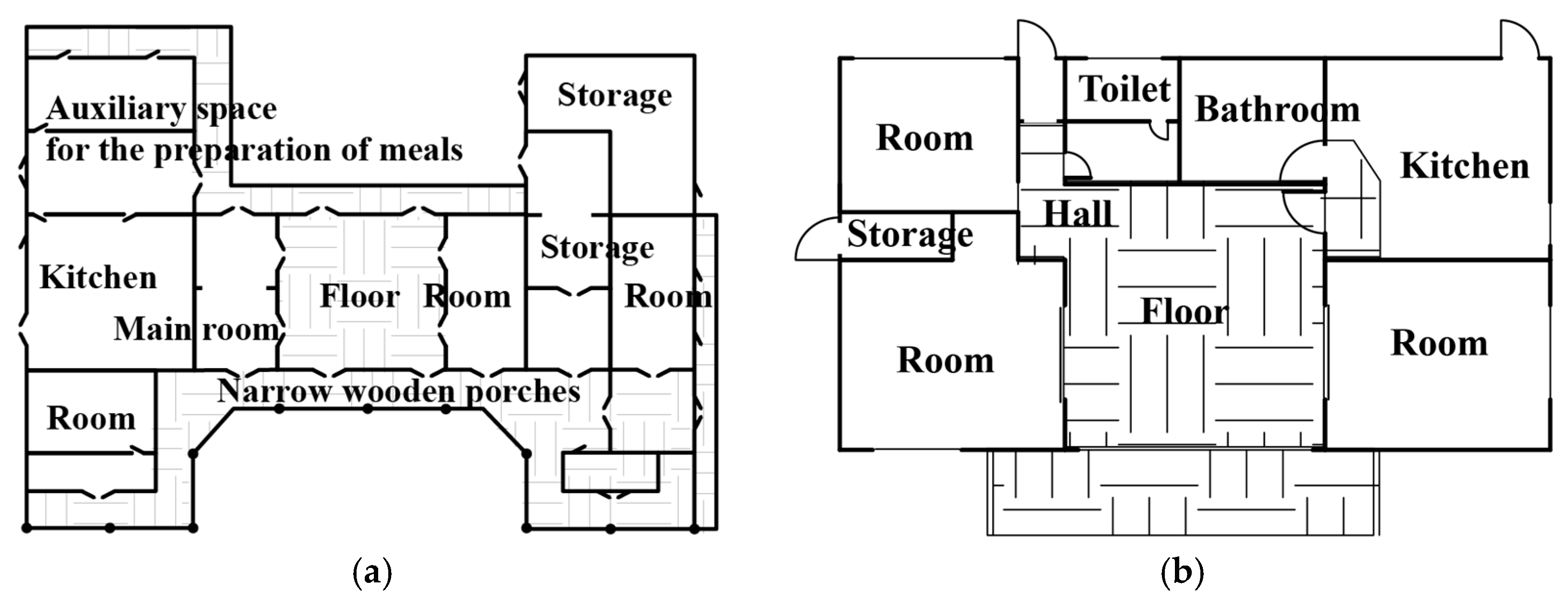
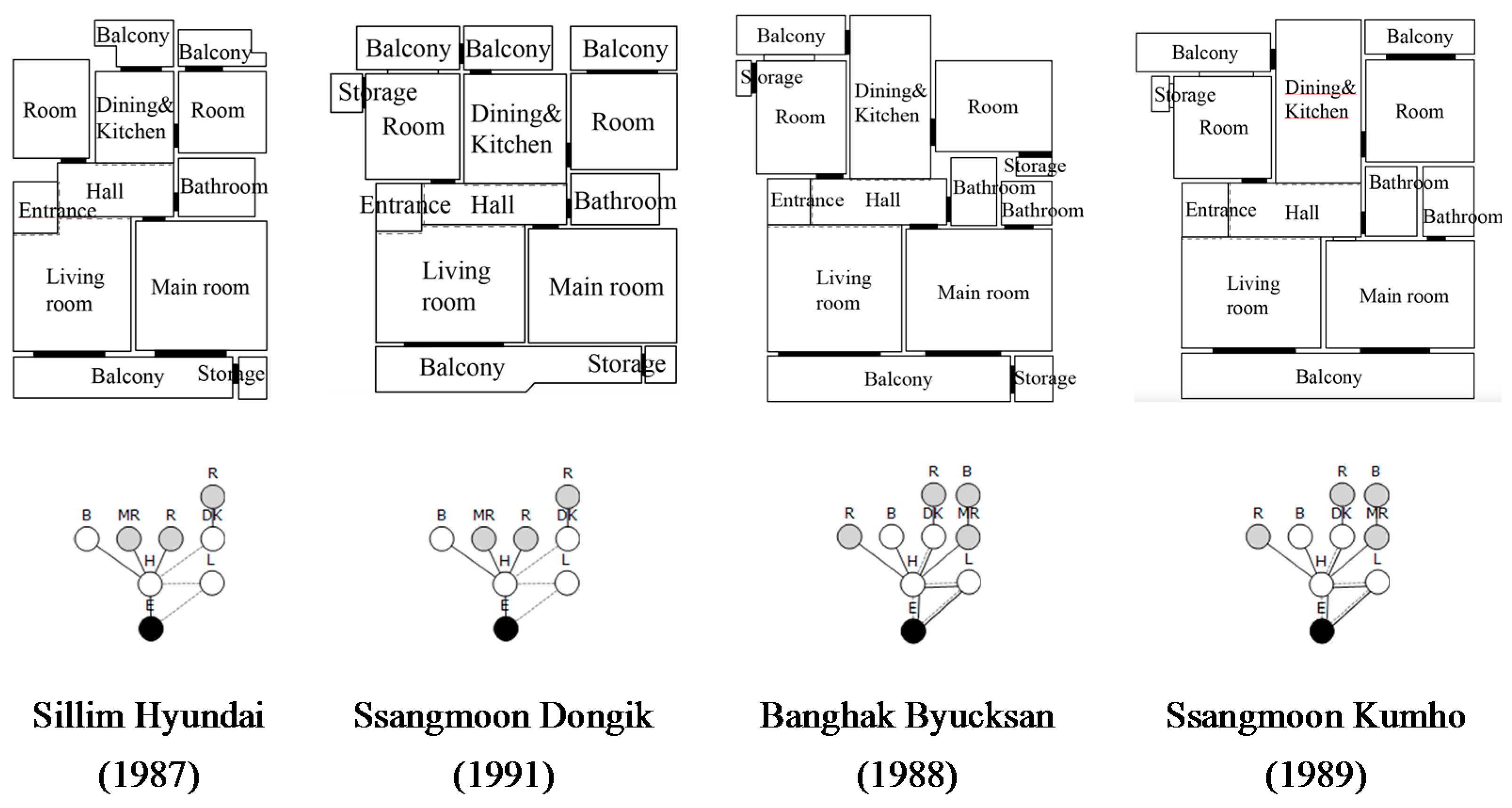
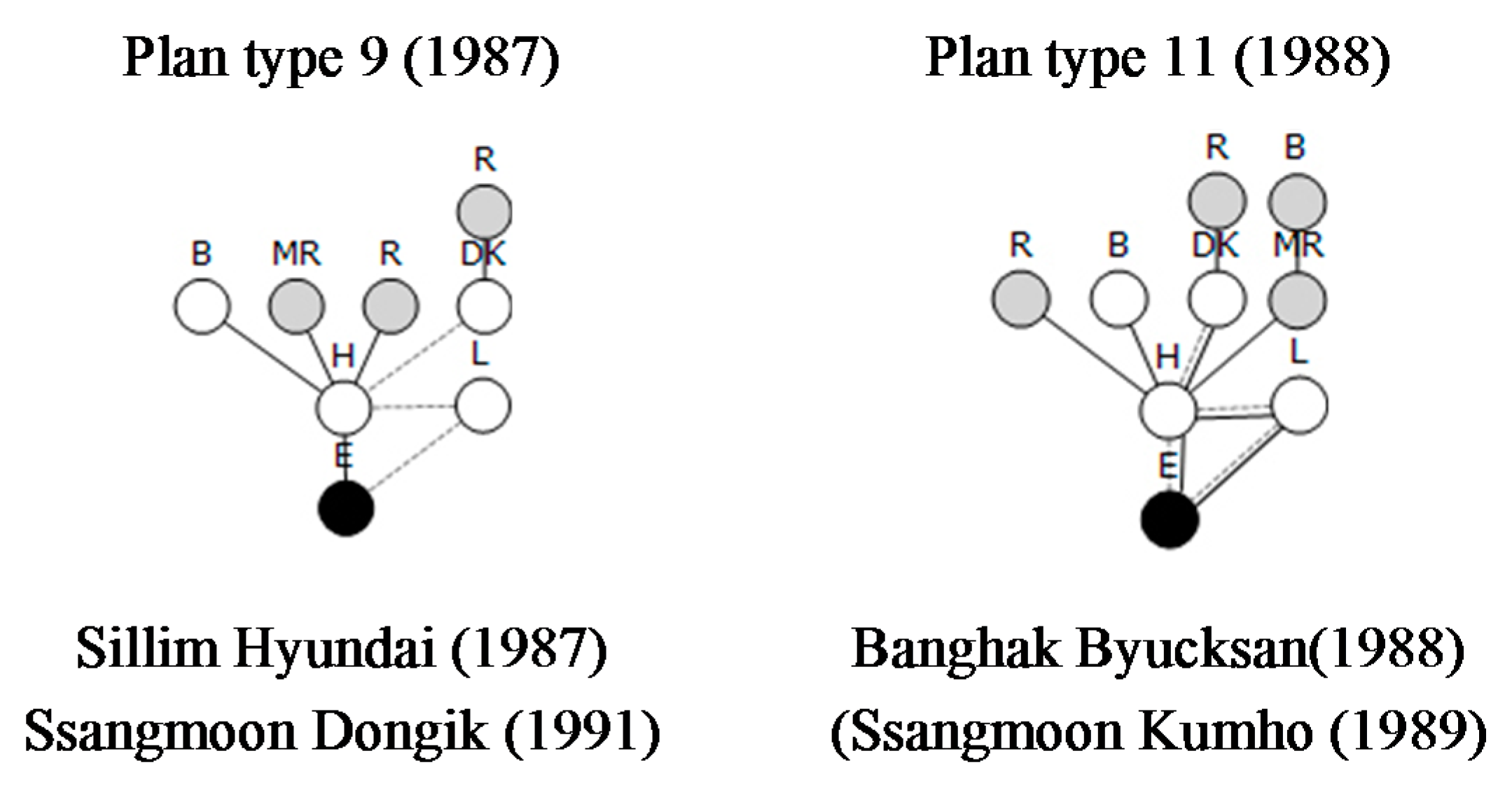

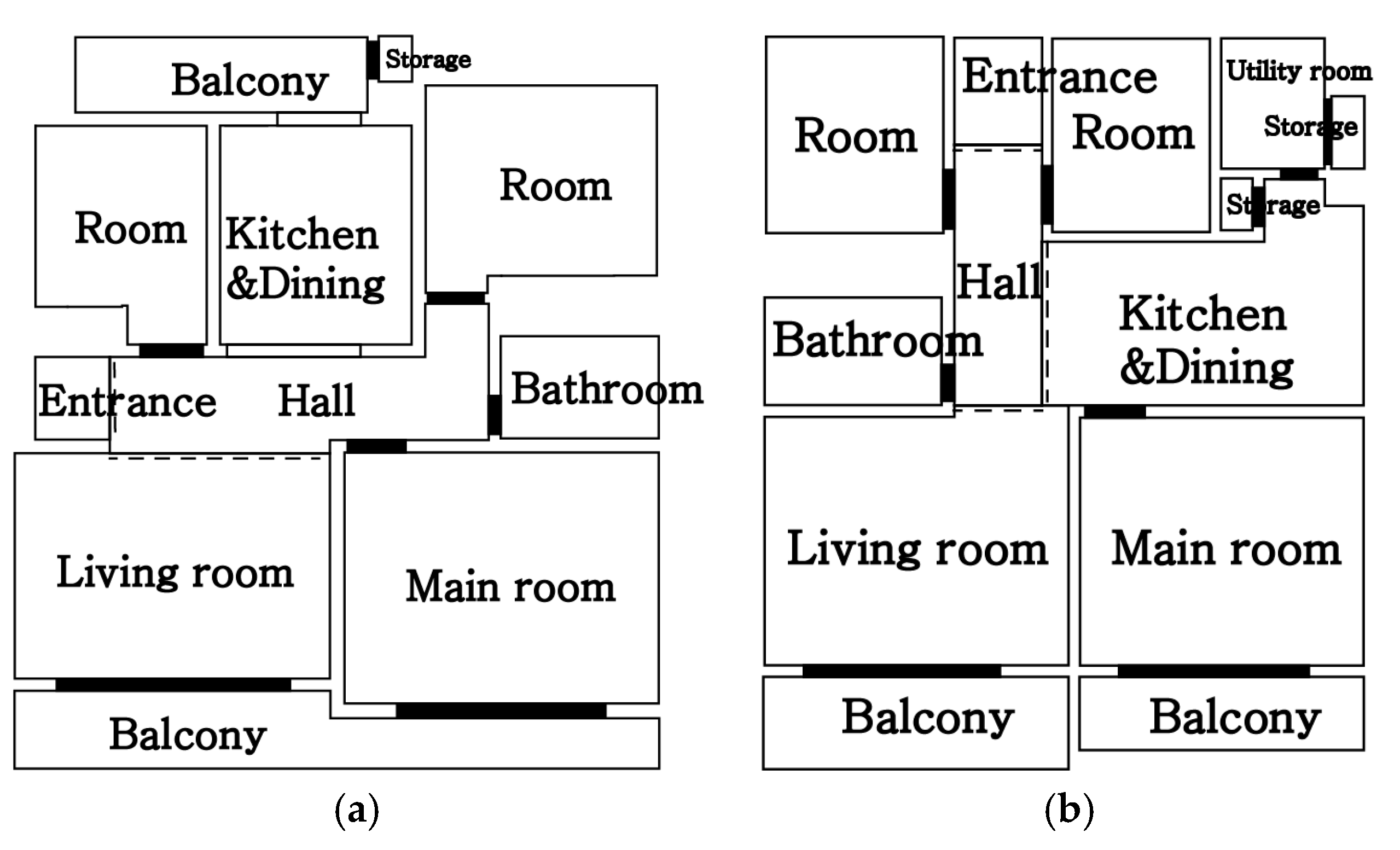

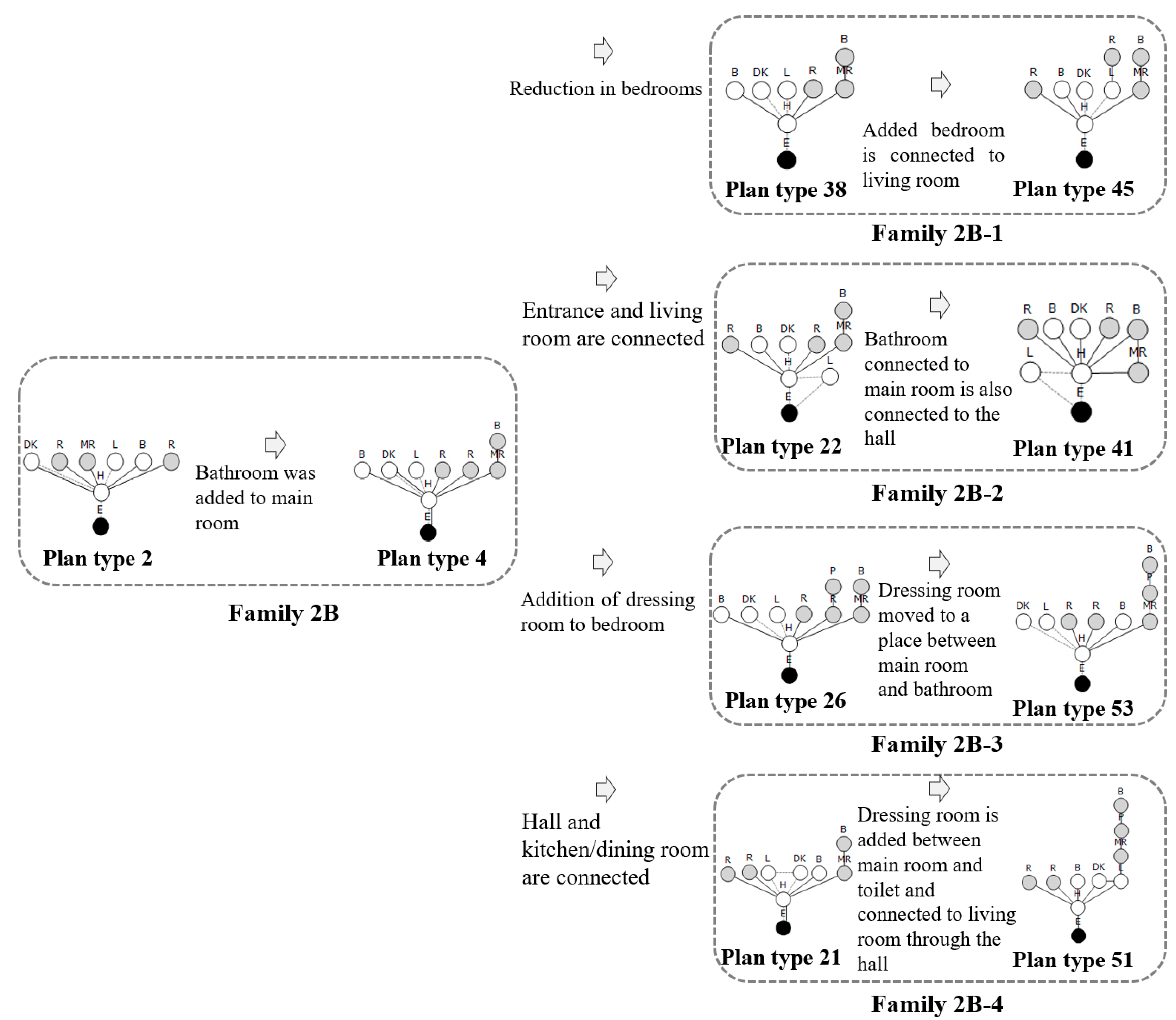


| ID | Year (Count) | Count | Similarity Score | Matching ID | Family and Spatial Genotype |
|---|---|---|---|---|---|
| 1 | 79 (1) | 1 | 0 | 0 | 2A, KB-HA-EA-MA |
| 2 | 80 (1), 82 (1), 83 (9), 84 (4), 85 (5), 86 (6), 87 (3), 88 (8), 89 (1), 90 (2), 93 (1), 94 (1) | 42 | 0.817 | 1 | 2B, KA-HA-EA-MA |
| 3 | 82 (1), 84 (1), 88 (2), 89 (1), 91 (1), 92 (1) | 7 | 0.857 | 1 | 2A, KB-HA-EA-MA |
| 4 | 82 (1), 83 (1), 86 (1), 88 (1), 92 (1), 93 (1), 94 (1), 98 (1), 01 (1), 04 (2), 05 (1), 06 (1), 07 (1) | 14 | 0.881 | 2 | 2B, KA-HA-EA-MA |
| 5 | 84 (1) | 1 | 0.687 | 2 | 2B, KA-HA-EA-MA |
| 6 | 86 (1), 88 (6), 89 (9), 90 (4), 91 (12), 92 (18), 93 (12), 94 (5), 95 (18), 96 (11), 97 (5), 98 (6), 99 (11), 00 (3), 01 (7), 02 (5), 03 (1), 04 (2), 05 (2), 06 (1), 07 (1), 09 (1), 13 (1) | 141 | 0.886 | 3 | 2A, KB-HA-EA-MB |
| 7 | 86 (1) | 1 | 0.583 | 1 | 2A, KD-HA-EB-MA |
| 8 | 87 (1) | 1 | 0.736 | 7 | 2A, KD-HA-EA-MA |
| 9 | 87 (1), 91 (1) | 2 | 0.886 | 3 | 2A, KA-HA-EB-MA |
| 10 | 87 (1) | 1 | 0.818 | 6 | 2A-2, KB-HA-EB-MB |
| 11 | 88 (2), 89 (1), 90 (5), 91 (9), 92 (15), 93 (16), 94 (26), 95 (15), 96 (19), 97 (37), 98 (52), 99 (69), 00 (52), 01 (28), 02 (24), 03 (25), 04 (15), 05 (7), 06 (6), 07 (4), 14 (1), 15 (1) | 429 | 0.908 | 10 | 2A-2, KB-HA-EB-MB |
| 12 | 88 (1), 92 (1), 95 (2), 97 (1), 99 (1), 08 (1) | 7 | 0.874 | 6 | 2A-1, KC-HA-EA-MB |
| 13 | 88 (1) | 1 | 0.888 | 2 | 2A-1, KA-HA-EA-MA |
| 14 | 89 (3), 90 (2), 92 (1), 93 (3), 94 (6), 95 (6), 96 (1), 97 (1), 00 (7), 01 (4), 02 (2), 04 (1), 06 (1) | 38 | 0.875 | 12 | 2A-1, KC-HA-EA-MB |
| 15 | 89 (1), 90 (1), 91 (4), 92 (7), 93 (5), 94 (8), 95 (1), 96 (5), 97 (8), 98 (13), 99 (10), 00 (9), 01 (6), 02 (2), 03 (7), 04 (4), 05 (5) | 96 | 0.891 | 11 | 2A-2, KC-HA-EB-MB |
| 16 | 90 (1) | 1 | 0.875 | 12 | 2A-1, KC-HA-EA-MB |
| 17 | 90 (1) | 1 | 0.889 | 11 | 2A-2, KB-HA-EB-MB |
| 18 | 90 (1) | 1 | 0.721 | 15 | 2A-2, KD-HA-EB-MB |
| 19 | 91 (1) | 1 | 0.881 | 2 | 2B, KA-HA-EB-MA |
| 20 | 91 (1), 92 (1), 02 (1), 05 (1) | 4 | 0.901 | 6 | 2A-2, KB-HA-EA-MB |
| 21 | 92 (1), 93 (1), 96 (2), 98 (1), 99 (1) | 6 | 0.87 | 4 | 2B-3, KA-HB-EA-MB |
| 22 | 92 (2), 98 (1), 99 (1), 00 (1), 04 (3), 05 (1), 07 (1) | 10 | 0.896 | 4 | 2B-2, KA-HA-EB-MB |
| 23 | 92 (1) | 1 | 0.8 | 17 | 2A-2, KA-HA-EB-MB |
| 24 | 92 (1) | 1 | 0.901 | 14 | 2A-1, KC-HA-EC-MB |
| 25 | 92 (1), 94 (1), 95 (1) | 3 | 0.827 | 11 | 2A-2, KC-HA-EC-MB |
| 26 | 92 (1) | 1 | 0.896 | 4 | 2B-4, KA-HA-EA-MB |
| 27 | 93 (1) | 1 | 0.827 | 18 | 2A-2, KE-HA-EB-MB |
| 28 | 93 (1) | 1 | 0.875 | 12 | 2A-1, KC-HA-EB-MA |
| 29 | 93 (1) | 1 | 0.878 | 14 | 2A-1, KD-HA-EA-MB |
| 30 | 93 (1), 96 (1), 00 (1) | 3 | 0.878 | 12 | 2A-1, KD-HA-EA-MB |
| 31 | 94 (1), 95 (1), 97 (2), 99 (1), 00 (1), 02 (2) | 8 | 0.899 | 12 | 2A-1, KC-HA-EB-MB |
| 32 | 94 (1) | 1 | 0.899 | 27 | 2A-2, KD-HA-EA-MB |
| 33 | 94 (2), 95 (1), 97 (1), 98 (2), 99 (1), 00 (1), 01 (2), 02 (1), 03 (2) | 13 | 0.899 | 30 | 2A-1, KD-HA-EB-MB |
| 34 | 94 (1) | 1 | 0.853 | 30 | 2A-1, KD-HB-EA-MB |
| 35 | 96 (1) | 1 | 0.887 | 14 | 2A-1, KC-HA-EA-MA |
| 36 | 97 (1), 01 (1) | 2 | 0.899 | 7 | 2A, KD-HA-EB-MB |
| 37 | 98 (1) | 1 | 0.878 | 7 | 2A, KC-HA-EB-MA |
| 38 | 98 (1) | 1 | 0.886 | 4 | 2B-1, KA-HA-EA-MB |
| 39 | 99 (1), 06 (1) | 2 | 0.761 | 11 | 2A-2, KB-HA-EA-MB |
| 40 | 99 (1) | 1 | 0.887 | 16 | 2A-1, KC-HA-EA-MA |
| 41 | 99 (1) | 1 | 0.884 | 22 | 2B-2, KA-HA-EA-MB |
| 42 | 01 (1), 02 (2), 03 (1), 04 (4), 07 (1) | 9 | 0.9 | 10 | 2A-2, KB-HA-EB-MC |
| 43 | 01 (1), 02 (1), 03 (3), 04 (1), 05 (1), 06 (3) | 10 | 0.95 | 10 | 2A-1, KB-HA-EB-MD |
| 44 | 02 (2), 03 (3), 04 (2), 05 (1), 06 (1) | 9 | 0.904 | 42 | 2A-2, KC-HA-EB-MC |
| 45 | 02 (1) | 1 | 0.853 | 38 | 2B-1, KA-HA-EA-MB |
| 46 | 03 (2) | 2 | 0.899 | 16 | 2A-1, KE-HA-EB-MB |
| 47 | 03 (1) | 1 | 0.746 | 25 | 2A-2, KC-HB-EA-MB |
| 48 | 03 (1) | 1 | 0.844 | 30 | 2A-1, KD-HA-EA-MC |
| 49 | 03 (1), 04 (1) | 2 | 0.95 | 44 | 2A-2, KC-HA-EB-MD |
| 50 | 04 (1) | 1 | 0.8 | 47 | 2A-2, KB-HB-EA-MC |
| 51 | 04 (1) | 1 | 0.774 | 21 | 2B-3, KA-HA-EA-MC |
| 52 | 04 (1) | 1 | 0.909 | 44 | 2A-1, KC-HA-EA-MC |
| 53 | 05 (1) | 1 | 0.889 | 26 | 2B-4, KA-HA-EA-MC |
| 54 | 05 (1) | 1 | 0.836 | 39 | 2A-1, KB-HA-EA-MC |
| 55 | 05 (1) | 1 | 0.766 | 43 | 2A-1, KC-HB-EA-MC |
| 56 | 05 (1), 10 (1) | 2 | 0.871 | 39 | 2A-2, KB-HA-EA-MB |
| 57 | 06 (1) | 1 | 0.892 | 23 | 2A-2, KA-HA-EA-MC |
| 58 | 06 (1), 11 (1) | 2 | 0.909 | 48 | 2A-1, KD-HA-EB-MC |
| Family 2A | Family in which any spaces (rooms) are connected through the kitchen and dining room (DK) (DK-*) | 2A-1 | Only entrance is connected to the hall (E-H) |
| 2A-2 | Entrance, hall, and living room are inter-accessible (E-H, E-L, L-H) | ||
| Family 2B | Family in which all spaces are connected through the hall (H-all spaces) | 2B-1 | Bedrooms are accessible via the living room (L-R) |
| 2B-2 | A complex type of plan type 2A-2 in which the entrance, living room, and hall are inter-accessible (E-H, E-L, H-L) | ||
| 2B-3 | Addition of dressing room (R-P and MR-B are changed to MR-P-B.) | ||
| 2B-4 | Living room, kitchen/dining room, and hall are inter-connected, and the dressing room is located beside the bathroom, as shown in plan type 2B-3 (L-DK, L-H, DK-H, MR-P-B) |
© 2016 by the authors; licensee MDPI, Basel, Switzerland. This article is an open access article distributed under the terms and conditions of the Creative Commons Attribution (CC-BY) license (http://creativecommons.org/licenses/by/4.0/).
Share and Cite
Ham, S.; Lee, H. Topological Transitions in Collective Housing Units of South Korea. Sustainability 2017, 9, 31. https://doi.org/10.3390/su9010031
Ham S, Lee H. Topological Transitions in Collective Housing Units of South Korea. Sustainability. 2017; 9(1):31. https://doi.org/10.3390/su9010031
Chicago/Turabian StyleHam, Sungil, and Hyunsoo Lee. 2017. "Topological Transitions in Collective Housing Units of South Korea" Sustainability 9, no. 1: 31. https://doi.org/10.3390/su9010031
APA StyleHam, S., & Lee, H. (2017). Topological Transitions in Collective Housing Units of South Korea. Sustainability, 9(1), 31. https://doi.org/10.3390/su9010031






